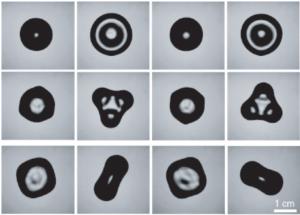When a water jet impinges upon a solid surface it produces a
so called
hydraulic jump that everyone can observe in the sink of its
kitchen. It
is characterized by a thin liquid sheet bounded by a circular
rise of
the surface due to capillary and gravitational forces. In this
phenomenon, the impact induces a geometrical transition, from
the
cylindrical one of the jet to the bi-dimensional one of the
film. A
true jet rebound on a solid surface, for which the cylindrical
geometry
is preserved, has never been yet observed. We have
experimentally
demonstrated that a water jet can impact a solid surface
without being
destabilized. Depending on the incident angle of the impinging
jet, its
velocity and the degree of hydrophobicity of the substrate,
the jet
can: i) bounce on the surface with a fixed reflected angle,
ii) land on
it and give rise to a supported jet or iii) be destabilized,
emitting
drops. Capillary forces are predominant at the sub-millimetric
jet
scale considered in this work, along with the hydrophobic
nature of the
substrat to explain why such capillary hydraulic jump gives
rise to
this unexpected jet rebound phenomenon.
|

|



